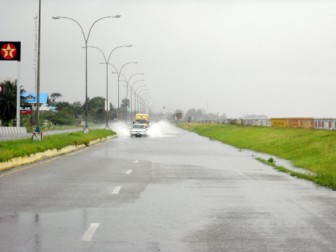Projects in Guyana have faced problems because of the poor services rendered by engineers, according to geotechnical engineer and groundwater hydrologist Charles Ceres.
“Our engineers: they can’t conceptualize and they can’t see beyond what they do and they’re not prepared to look beyond that,” Ceres told Stabroek News last week. The veteran engineer has expressed concern that there are several projects where design flaws are obvious and he told this newspaper that the engineers are not providing sound technical advice. Over the years, many infrastructural projects including major ones such as the Guyana Aquatic Centre and the Supenaam stelling have experienced problems resulting in hundreds of millions of dollars being spent to rectify the defects, adding to enormous construction costs.

The “engineering failures” cut through the public and private sectors, Ceres- the managing director of Ground Structures Engineering Consultants Inc – said. There is a paucity of individuals in Guyana who can conceptualize exactly how to solve problems, he asserted. “They can’t define the problem then come up with a proper solution.” Ceres stated that the engineers tend to think that what was applicable in the past is applicable now.
With regards to infrastructural projects, Ceres said that engineers are supposed to provide service to the employer that is indicative of the quality of the profession at that stage but this is not happening in Guyana. He cited the construction of the East Coast Demerara (ECD) highway and the extension of the East Bank Demerara road saying that the hard material on top is being removed. “That is not state of the art engineering,” Ceres said pointing out that there is about a meter and a half of stiff clay and underneath is material that is “almost like soup” which takes a very long time to settle. He said that when the hard material is removed, the more competent material to build upon is removed and this is “stupidity.”
Depression

The road will continue to settle over the years, he said, while local engineers argue that this is always how they have done it. He noted that when it rains, water accumulates on the ECD highway between Georgetown and Sparendaam and this is because the road is settling as well as poor drainage. He questioned whether feasible solutions have been examined. He pointed out too that the approaches to bridges and culverts have a big depression and this is dangerous. Engineers are not looking for solutions but the issues can be solved, Ceres said. The population is not being provided with the quality of service for the money spent, he added. “People spending taxpayers money in this country like they don’t care because as far as (they’re) concerned, if it ain wuk now, they gon put more money and it gon wuk the next time.”
Ceres said that the Guyana Association of Professional Engineers (GAPE) should be telling the engineers about the issues being experienced but they have a certain reticence about being critical because they would have to be critical of their own members. He said that in Guyana, when a person comes out of the University of Guyana with an engineering degree, that person is classified as an engineer while in other jurisdictions; tests such as a professional certification exam would have to be passed before someone can call themselves an engineer. Even GAPE, he said, has not been holding conferences where technical papers are presented as happens elsewhere.
Bad roads
“All the bad roads getting built has nothing to do with the contractor but the engineers on the job because if the engineer effects proper supervision on the job and proper quality control these things will not happen but the engineers themselves don’t have a clue what is going on,” Ceres told Stabroek News. He said that contractors do what the engineers allow them to do and cannot do anything without the approval of the engineer. “When a man put poor quality material on a road, it is the engineer who approved it,” he said adding however, that the situation is different when it is a design/build contract but “it comes back to engineering.”
He said that engineers are supposed to optimize the use of their clients’ money but this is not happening and the “engineering failure” is not confined to the public sector but is across the board. In Trinidad, building a house requires the submission of a number of plans to authorities before approval is granted while in Georgetown, for a six-storey building, only a line plan is required, he said.
Ceres said that his company tends to stay away from government projects because the people who the engineers are supposed to advise do not know any better than the engineers. “We want to work with people who have a sense of what is it they are looking to accomplish and I get the impression that the technical people who the Government of Guyana have working for them don’t have a sense of what they’re looking to accomplish,” he declared.
In Guyana, maintenance of infrastructure is a problem, Ceres stated too. He said that flooding will occur because there are no effective maintenance systems in place. With respect to statements by the authorities that rainfall has increased, he said that no one, to his knowledge, has ever done an analysis of the historical rainfall Guyana has had but he believes that if they do, they will find out that the country is experiencing no more rain than in the past. Global warming is being blamed for the “increased” rainfall but no analysis of the historical data has been done to establish that rainfall has indeed increased, he said. “I don’t think we are having any more rainfall than we have been having in the past. What I think we’re having is we have greater intensity of rainfall but cumulatively I don’t think we have more rainfall,” Ceres said.
Lateral transport
Because of the silted up canal outfalls in Georgetown, the water cannot run off as effectively as it is able to, he said while adding that there is also less capacity in terms of drainage and holding water. He noted that outfalls are silted up because of lateral transport along the coast. There is erosion at one place and deposition elsewhere and this will compromise the outfalls at some locations, he said, while asking whether anything is being done to maintain those outfalls.
Furthermore, Ceres pointed out that the Housing Ministry has been allocating land for house lots but makes no provision for storm water management facilities in those housing areas so when it rains, those places flood.
Meanwhile, in relation to the problematic East Demerara Water Conservancy, Ceres said that he does not believe that anyone has done a definitive analysis to show that there is a need for it. When the conservancy was built, he said, it was with the intent that it would supply water to Georgetown. However, he said, the city uses mostly groundwater and there are a “whole lot of losses in the line.” If there were no losses there would have been no need to take water from the conservancy for Georgetown, he said.
Ceres said that the Guyana Sugar Corporation says that they need it for their cultivation but they keep pumping water out into the sea while for rice farmers, a needs analysis should be done to determine how much they need to raise rice. “The paradoxical thing about this whole thing is that we can have a flood today and a drought tomorrow…that is the level of water management we have in this country,” he said. Ceres was a member of the EDWC task force after the 2005 Great Flood and said that he did not accept payment because the work that they were asked to do was not technical.
No one has been able to prove that the EDWC is needed, he argued, adding that he does not think it supplies any village along the coast with potable water only agricultural water. While he would not comment on the status of the conservancy because he said that the data has to be quantified, he said that if there is a need for it, there is a need for maintenance of it.
Widespread
Ceres said that the engineering failures in this country are widespread. He said that there is an engineering solution to GPL’s 30% technical power losses while in the case of the infamous Charity floating wharf, he did the forensic study for the government in 1997. He said the contractor was not at fault but up to now has not been paid. “The engineer was at fault. The engineer design was flawed. The contractor build exactly what the engineer tell he to build,” Ceres said.
The problems are not only at the level of the public sector, he said. He pointed to TCL’s cement bagging plant and said that the engineering company was fired by TCL because “they did a set of nonsense.” In addition, it cost the St. Joseph Mercy Hospital more to underpin the sinking new wing of the hospital than to build it, he said.
Engineers have to sign off on what the contractors do, he said. “First of all, they got to design it to make sure it’s functional, then they got to supervise it to make sure it’s built effectively,” Ceres said. However, he said, “the mentality the engineers have is that this is how we used to do it in 1930s. They’re archaic in the way they think.” Ceres added that there are a few who have been doing what they are supposed to do.








